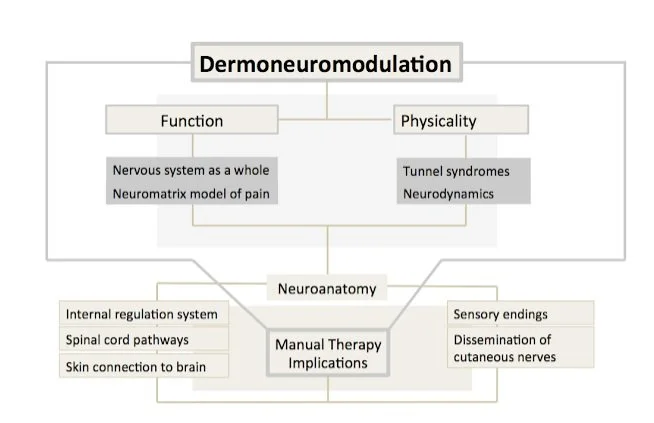Chronic pain is a complex issue affecting millions of people, often lasting months or even years. Unlike acute pain, which serves as a warning for injury, chronic pain can persist even after the underlying injury or condition has healed. For those dealing with ongoing pain, managing daily discomfort and maintaining quality of life can be challenging. Registered Massage Therapists (RMTs) play a key role in supporting those living with chronic pain, using a range of therapies designed to help reduce pain, improve mobility, and enhance overall wellness. One such approach, called Dermoneuromodulation (DNM), is increasingly recognized for its effectiveness in managing chronic pain conditions.
Understanding Chronic Pain
Chronic pain often extends beyond physical injury and can affect emotional well-being and mental health. Conditions like fibromyalgia, arthritis, migraines, and persistent low back pain are common forms of chronic pain that many individuals experience. These conditions don’t just cause discomfort—they can limit mobility, reduce energy, and disrupt daily life. The goal of massage therapy for chronic pain is not only to manage physical pain but also to support holistic well-being, enabling patients to live more comfortably and confidently.
How Massage Therapy Helps with Chronic Pain
Massage therapy offers several benefits for individuals with chronic pain:
Reduces Muscle Tension: Chronic pain can lead to muscle guarding, which is when muscles remain tense to protect an area of the body. Massage therapy helps release this tension, allowing muscles to relax and restoring natural movement patterns.
Enhances Mental Health: Chronic pain often leads to anxiety, depression, and stress. Massage therapy promotes relaxation by stimulating the body’s parasympathetic nervous system, which can decrease stress hormones and improve mental well-being.
Encourages Body Awareness: By working with an RMT, individuals can become more attuned to their body’s ’ needs, patterns, and postural habits, which can be transformative in managing chronic conditions.
What is Dermoneuromodulation (DNM)?
One specific approach gaining attention in the world of chronic pain management is Dermoneuromodulation (DNM). Developed by Canadian therapist Diane Jacobs, DNM is a gentle, non-invasive technique that focuses on the nervous system and skin (dermis). Unlike traditional massage techniques that target deeper muscles and tissues, DNM works on the skin to interact with the nerves and receptors that play a crucial role in chronic pain perception.
DNM is based on the concept that the skin and nervous system are intricately connected. By gently mobilizing the skin, RMTs can reduce nerve sensitivity, which can alleviate pain. This technique can be highly effective for individuals with chronic pain conditions like fibromyalgia, carpal tunnel syndrome, and nerve-related pain, as it addresses both the sensory and neural components of pain.
Why DNM is Effective for Chronic Pain
Chronic pain is often associated with an overactive nervous system, where nerves become hypersensitive to stimuli. DNM directly targets this hypersensitivity by focusing on the skin’s nerve endings, influencing how the brain perceives pain. This unique approach can help “reset” the nervous system, leading to reduced pain levels and improved comfort.
Some key benefits of DNM for chronic pain include:
Gentle on Sensitive Areas: For individuals who experience discomfort with traditional massage techniques, DNM offers a gentle alternative that’s less likely to trigger pain.
Reduces Neural Tension: By working with the skin, RMTs can help reduce neural tension, which can have a significant impact on overall pain levels.
Increases Nervous System Modulation: DNM supports the nervous system in modulating its response to stimuli, making it a powerful tool for chronic pain management.
Conditions that Benefit from DNM and Massage Therapy
Massage therapy, including techniques like DNM, is beneficial for a variety of chronic pain conditions:
Fibromyalgia: Known for causing widespread pain and fatigue, fibromyalgia is often accompanied by sensitivity to touch. DNM’s gentle approach is ideal for managing fibromyalgia pain, as it doesn’t over-stimulate sore areas.
Migraines and Headaches: Massage therapy can address the muscle tension and stress associated with chronic headaches, while DNM can reduce nerve hypersensitivity in the head and neck regions.
Arthritis: Massage therapy relieves stiffness and increases joint mobility, while DNM can ease pain by reducing nerve sensitivity in affected areas.
Low Back Pain: Chronic low back pain often involves muscle tension and nerve sensitivity. Massage therapy and DNM together can target both muscle tightness and neural elements for a comprehensive approach to pain relief.
What to Expect in a Massage Therapy Session for Chronic Pain
At your first session, an RMT will discuss your pain history and goals for treatment, helping to determine the best approach. DNM, for example, may be used in conjunction with other techniques such as myofascial release or joint mobilization, depending on your needs. Sessions are typically designed to be relaxing and focused on areas where pain or tension are most present.
Your RMT may also provide guidance on at-home exercises and stretches to further support your progress between sessions. Building body awareness and integrating mindful movements can help individuals manage chronic pain more effectively, making massage therapy an essential part of a holistic pain management plan.
Embracing Long-Term Pain Relief with Massage Therapy
For those living with chronic pain, massage therapy offers more than just temporary relief; it supports long-term healing and comfort. Techniques like DNM can create meaningful change in pain perception, helping individuals regain control over their bodies and their lives. By integrating massage therapy with other healthcare interventions, RMTs in Kamloops, BC, are committed to helping patients manage chronic pain and achieve improved wellness.
If you’re ready to explore how massage therapy, including DNM, can help manage chronic pain, reach out to schedule a consultation. [Link to Book a Session]
For more on massage's therapeutic benefits, check out our article on Understanding the Role of a Registered Massage Therapist (RMT), where we discuss how RMTs are trained to provide specialized care for various conditions.

